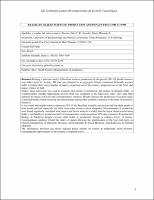Brazilian Health Sciences: Production And Impact From 1981 To 1995
Abstract
Ensuing a previous study of Brazilian sciences production for the period 1981-95, health sciences
were taken apart for scrutiny. ISI data was obtained in an aggregate format comprising 40 health research
fields recording their yearly number of papers, proportion out of the country, proportion out of the field, and
impact relative to field.
Simple linear regression was used to examine time trends in production and impact of research fields. A
complementary variable representing growth trend was computed as the regression slope. Data were then
analysed by means of Factor and Correspondence Analysis. Results allowed the production of location maps
of research fields so that hierarchy and relationships among them could be examined in the form of geometric
distances.
It was found that health sciences represent 42% of the Brazilian scientific production and that their trends in
both production and impact do not differ from other sciences taken altogether. Measurements of production
were found negatively correlated with impact and factor analysis revealed that the major distinction between
fields is attributable to production (64% of measurement variations against 19% due to impact). Experimental
Biology & Medicine largely exceeds other fields in production, though at ordinary levels of impact.
Correspondence analysis refined the study of impact allowing the identification of the best performers as
Clinical Immunology & Infectious Diseases, Environmental & Social Medicine, and Radiology & Nuclear
Medicine.
The information provided can advise national policy makers on science & technology about priorities
concerning the improvement of the country’s competitiveness.


